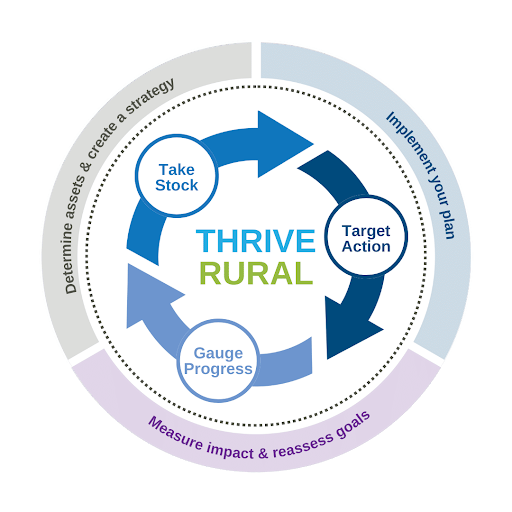Holly Enowski, SAFSF Senior Membership Associate, shares her reflections after attending two rural-forward convenings: 2024 Rural Philanthropy Summit: Creating Thriving Communities, presented by Philanthropy Missouri and Community Foundation of the Ozarks, and Building an Intersectional Philanthropic Approach: Climate Change, Agriculture, and Healthy Rural Communities presented by SAFSF.
Growing up in rural Missouri and now living in a town of 250, I have a keen awareness of the issues impacting rural communities and a deep desire to create a stronger, thriving rural Midwest. My summer has been full of travel – joining fellow PSO, Philanthropy Missouri, for their recent rural-focused summit, and meeting with over 80 climate, energy, and agriculture funders, and community leaders on our latest SAFSF On The Road stop in Minneapolis.
Both events served as powerful reminders of the power of bringing funders together with community leaders. I left southern Missouri energized by the research from a recent report by Aspen Institute Community Strategies Group that addresses questions often asked by those who shepherd resources, with answers informed by rural practitioners. A takeaway: “think and work region” – advance, apply, and adapt strategies from one community to another and create collaborative efforts across county and city lines. The plenary message at the Rural Philanthropy Summit was more critical but also a clear call to action: “National philanthropy has no idea what is happening on the ground.”
In Minneapolis, our convening underscored the need to be place-based and community-centered as we address the urgent need to invest in rural communities and agriculture as essential strategies for climate mitigation and resilience. Implementing comprehensive, systemic interventions to address challenges are a must-have. From a localized state convening to a Midwest regional convening, the lessons are applicable.
A few points to draw out:
For rural areas to thrive, those most impacted need to be at the forefront.
As discussed in Minneapolis, rural land stewards and BIPOC communities bear the brunt of climate change effects, and should be at the forefront of solutions, included before and throughout the investment process.

The conversation in Missouri, led by Bonita Robertson-Hardy of the Aspen Institute, explored the Thrive Rural Framework, a tool to develop a multi-stakeholder approach to rural development that leverages ongoing work in communities.. Critically, the Framework confronts the unique types of structural discrimination people in rural communities and Native nations face. In partnership with leaders, practitioners, policymakers, and other rural prosperity champions, rural voices should be uplifted, elevated, and prioritized.
Rural communities must acknowledge the sovereignty of federally and state-recognized American Indian tribal communities and Alaska Native nations, communities that are also impacted by the issues we work on. We cannot have rural conversations without bringing in the voices of Native, Tribal, and Indigenous communities. Shelley Buck, Former President of the Prairie Island Tribal Council, emphasized the need to engage Tribal Nations, not just Native nonprofits or urban Native communities in this work.
Turn shared possibilities into collective realities.
How can we – funders, community leaders, and rural partners – work together to respond to the challenges facing rural communities and regions? Many best practices are found in the work of Rural Development Hubs, intermediaries that are doing development differently in rural America, as frameworks to build a healthy, inclusive, and equitable America. While in Minneapolis, Reginaldo Haslett-Marroquin, Co-Founder and CEO of Tree-Range Farms, echoed: “We need a movement from funding projects to funding systems so that we may solve things at the level that they need to in order to achieve the future we keep talking about.”
Recognize that thriving rural communities contribute to the entire state, region, and country.
The narrative of rural versus urban does not work. The conversations can no longer be siloed; we need to push a new narrative of rural, one that leads with opportunities and focuses on local capacity. In the Midwest, many rural communities are fodder for production of corn and soybeans, propelled by agricultural policies and economic incentives, yet there is so much potential for crop diversification, carbon capture and storage, and robust community development. When the conversation shifts from a deficit and scarcity mindset to one of community abundance, we are able to think, work, and act in a way that is holistic of the food system and world we want.
View the totality of wealth in a community.
Financial, natural, cultural, social, and other types of wealth are assets that create the totality of wealth; these types of wealth are often not documented or accounted for in discussions of community economic development. In rural communities, social wealth is particularly strong – ‘everybody knows everybody’ – and leveraging the social capital is an important mechanism for change. How are external partners and funders valuing your community assets? Does they reflect an understanding of the full picture of what is in your thriving community?
To the argument that rural people should pursue economic opportunities in urban areas, to use a popular adage, ‘the math is not math-ing.’ This argument is short-sided and misguided, failing to recognize the nuance and complexity of how people are connected to their communities and their places. As funders, it is critical to look beyond the bottom line, to develop a full sense of what a place and its people have to offer. Alongside Tree Range Farms and Just Food Co-op, the Minneapolis site visit to a poultry-centered regenerative agroforestry system demonstrated ecosystem change and value chain coordination, while providing employment opportunities to local youth and connecting the community to the land.
‘Local’ can and should influence systems change. We can learn from local practitioners, communities, and funders on what is needed and equally what is not. Increased funding and investment builds momentum from projects to systems, advancing a movement forward; more on community-led power-building strategies in the Minneapolis convening closing panel.